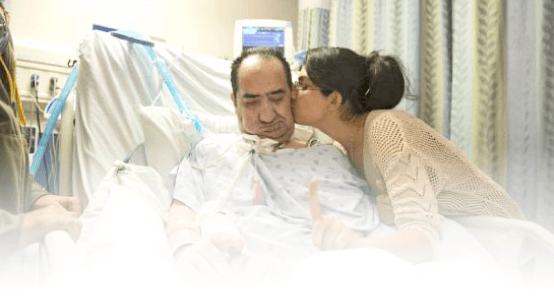Podcast: Play in new window | Download
Subscribe: Apple Podcasts | RSS
Quick Tip for Families in Intensive Care: My Dad is in Septic Shock in ICU After Getting Infected in LTAC (Long- Term Acute Care). How Should ICU Treat Him?
Hi, it’s Patrik Hutzel from intensivecarehotline.com with another quick tip for families in intensive care.
Today’s tip is another question answered from one of our members. And it’s actually the sequel from my video yesterday, where I answer a question from our member here who had their dad go into LTAC (long-term acute care) from ICU. And for any one of you following my videos for quite some time, we strictly advise against LTAC.
So, the next question that our member has, I will read out in a minute. If you want to become a member in our membership for families of critically ill patients in intensive care, go to intensivecarehotline.com and click on the membership link or go directly to intensivecaresupport.org. And as part of our membership, we answer all questions, intensive care related in a membership area and via email.
So, let’s get to our member’s question says,
“Hi Patrik and Team,
He was in LTAC for 10 days and went into septic shock. I had to fight with the infectious disease doctor the whole time to give him the antifungal antibiotics prescribed at the hospital, and he went into septic shock from bacteria instead. Back-to-back septic shock from blood infections – I don’t even know how this is possible.
He has been in the ICU for 15 days now, recovering from the second septic shock. I have tried to discharge him four times from the ICU in these 15 days. He is not ready. Give him a minute.
Praying so hard for my dad’s health and reasonable doctors and nurses.”
And when you look at the video yesterday, her dad went from ICU to LTAC and she was fighting with the doctors, whether her dad should continue the antibiotics being prescribed in ICU and they didn’t want to and now he’s in septic shock. No surprises there.
We always advise not to go to LTAC. And if you think you are forced to go to LTAC, please contact us as a matter of urgency. We have proven strategies on how to avoid LTAC. There are interviews on our podcast where clients confirm what I’m saying here.
So, let’s get to our answer.
The primary goal in managing septic shock is to restore the hemodynamic stability of your dad, to identify and control the infection. There are indicators for hemodynamic stability before we can say that your dad has recovered from shock. His cardiac activity, blood pressure, pulse, heart rate, capillary refill or perfusion, his conscious level, respiratory status, urinary output, body temperature, blood electrolytes glucose and gastrointestinal support and if the patient is already responding to the treatment of his illness.
Empiric antibiotic therapy is often given to patients who have an unidentified, proven, or suspected infection. The responsible organism of the bacteria has not yet been confirmed but to fight the infections early, a broad-spectrum antibiotic is started as soon as possible. Before the start of an antibiotic administration, blood culture, respiratory tract culture, MRSA (Methicillin-resistant Staphylococcus aureus) routine swab culture, complete blood count, C-reactive protein, (also known as CRP) and urine culture, et cetera are to be taken and examined to determine the cause of the microorganisms present in your dad’s body.
This blood culture and sensitivity tests will confirm the infection with pneumonia, coagulase negative or gram positives cocci, et cetera and will determine which antibiotic is appropriate to treat the causative microorganisms present in the patient’s body. It will also determine which antibiotic the patient is sensitive to or resistant to.
This is exactly what happened when her dad left ICU in the first place and then the LTAC did not want to follow instructions from ICU which is probably why he ended up in septic shock.
Your dad will continue to improve and recover from his illness if his ventilation, temperature, breathing, pulse, heart rate, nutritional status, urinary output and antibiotics treatment or his infection is being managed by the doctors. Always aim for normal vital signs, meaning, if he is with breathing difficulty, provide good oxygenation, suction, and clear his airway from secretions, administer saline nebulizers or nebulizers prescribed to him by his doctor, for example, Atrovent or salbutamol.
His body temperature must be within normal, and if he has a fever, have to treat his fever with antipyretic (anti-fever, medications like paracetamol and Tylenol or medicine prescribed to him by the doctor), do the tepid sponging to cool down and reduce his fever. Observe and monitor if his body temperature continuously increases or decreases, referring to the doctor immediately to avoid further complications like seizures, et cetera.
Check his pulse rate and blood pressure. If the blood pressure and the pulse rate or heart rate are low or high, immediately inform the nurse and the doctor for interventions, which is why he is in ICU for now so that they can do all of the above.
So, also with treating sepsis, in certain situations, steroids are being used. Furthermore, hemodynamic monitoring needs to be commenced, such as Swan – Ganz catheter monitoring to monitor cardiac output and cardiac index as well as SVR (systemic vascular resistance), and to see how far the septic shock is progressing and whether your dad is responding to treatment. So, no way they could do anything like it in LTAC.
So, again, the biggest challenge here is not to go to LTAC in the first place. The biggest challenge is that generally speaking, families in intensive care do not know what they do not know. They don’t know what to look for, they don’t know what questions to ask, they don’t know their rights and they don’t know how to manage doctors and nurses in intensive care. And that is exactly what you are dealing with here.
So that is my quick tip for today. I hope that helps and answers your questions as well.
Now again, if you want to become part of our membership for families of critically ill patients in intensive care, go to intensivecarehotline.com and click on the membership link or go to intensivecaresupport.org directly and get access there. In the membership, you have access to me and my team 24 hours a day in the membership area and we answer all questions, intensive care related.
I also offer one on one consulting, advocacy over the phone, via Skype, via email, via WhatsApp, Zoom, whichever medium works best for you. And I talk to intensive care teams directly. I talk to you and your family members helping you to steer this incredibly difficult territory that is intensive care, making sure that you make informed decisions, have peace of mind, control, power, and influence.
I also talk to doctors and nurses directly, which is probably where you have the biggest leverage by me doing that. I also represent you in family meetings with intensive care teams. If I was you, I would never go into a family meeting without clinical representation, without having a consultant advocate by your side, like myself, who can ask all the right questions, once again, so that you make informed decisions, have peace of mind, control, power and influence in those situations.
Now, we also offer medical record review in real time. If you need a medical record review, while your loved one is in intensive care, to get a second opinion, please contact us. We also offer medical record reviews after intensive care. If you have unanswered questions if you need closure or if you are simply suspecting medical negligence.
If you like my videos, subscribe to my YouTube channel for regular updates for families in intensive care. Click the like button, click the notification bell, share the video with your friends and families and comment below what you want to see next or what questions and insights are from this video.
Thanks for watching.
This is Patrik Hutzel from intensivecarehotline.com, and I will talk to you in a few days.
Take care for now.



